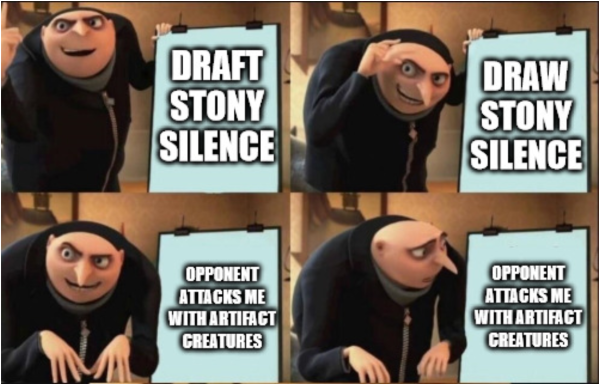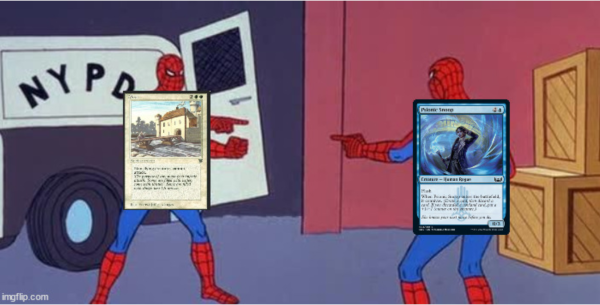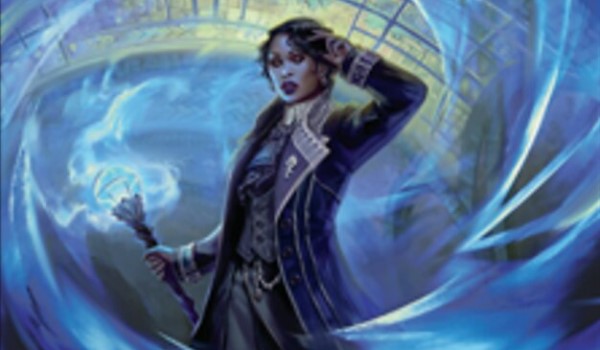Are you a Quiet Speculation member?
If not, now is a perfect time to join up! Our powerful tools, breaking-news analysis, and exclusive Discord channel will make sure you stay up to date and ahead of the curve.
Sideboarding is one of the most fascinating components of Magic the Gathering. One of Booster Draft's most enticing draws is the deck-building aspect. Whereas in Constructed, you build a deck once, in Limited you build a new one every draft. A strong sideboard strengthens your deck. It provides a more flexible approach, so you can tailor your game plan to each specific match-up.
In Draft, our sideboard is composed of every card we selected that did not make the final forty. Often times those final cuts are difficult to make. However, we would be wise to remember that just because we decided a card isn't in our best interest to include in our main deck, doesn't mean it's not an optimal choice for certain match-ups.
What Sideboarding Is Not
Be Realistic
In constructed, our sideboard is often full of floodgates, buttons, swiss-army knives, and other tools for specific strategies. If I know that a part of the metagame is Living End decks, then part of my plan needs to be bringing in Rest in Peace or Grafdigger's Cage. Because I know how powerful those decks are, I need to include powerful answers to stop them. While this is what we usually think of when we think of sideboarding, it is not a realistic solution in Draft.
First of all, we aren't likely to see many, if any, all-in strategies in Limited. Most Draft decks are versions of midrange strategies. They may lean aggressive or controlling, but in general, they play a well-rounded game plan balancing card advantage, removal, and creatures. Disrupting your opponent's graveyard or symmetrically taxing spells might provide a small advantage, but it's hard to imagine this shutting down a deck that probably plans on playing some number of above-rate creatures. If you're spending a card on graveyard hate, and your opponent is playing to the board, you're at a disadvantage.
Additionally, you have to actually use a draft pick on your hate cards. If you see a Blood Moon in a pack with other playables, you're probably better off just taking the on-color two-drop or removal spell that's going to be good for your deck. Focused answers, like we see in constructed, might seem appropriate but are still too narrow for even their relevant match-ups. Stony Silence can shut off some really powerful artifact abilities, but it doesn't guarantee you victory even in the match-up where you want it. Often times a creature would just be better.

What Sideboarding Is
While Constructed gameplay uses a mostly-scripted plan to utilize a sideboard, the Limited version is more imaginative. We probably don't have something that will completely shut down our opponent's game plan. However, we might be able to strengthen the way we approach the match-up.
Believe It Or Not, These Are Reasonable Sideboard Cards
One observation you might have made looking at these cards is that they are reasonable inclusions to your deck. In fact, you may not even consider them to be sideboard cards. That is not an accident. Deal Gone Bad is not a terrible card, and I might play it in the maindeck if I have some synergies or need the removal. However, when I'm playing against a Disciplined Duelist, Brokers Veteran, and Dapper Shieldmate with a toolbox of Murder, Strangle, and Maestros Charm the Deal Gone Bad goes from being a mediocre answer to a great one.
Case Study: Psionic Snoop
Psionic Snoop is a card that I am willing to maindeck, but would rather not. I've mentioned previously that any blue card with connive is worth playing, and I still think that is mostly true. However, I'm not thrilled at the prospect of using a card on a 1/4.
Snoop Dogs 'Em
If I see an aggressive start from my opponent in game one, and a flurry of low-toughness creatures are taxing my few removal options, Psionic Snoop can be a difference maker. When you feel confident that the 1/4 body is an asset to your game plan, the flash and connive make this card feel like a lot of added value. It won't win you the game on its own, but a Horned Turtle with flash goes from being a below-average card (perhaps slightly worse than your twenty-third) to one of the better cards in the deck.
Bricking an army of Gathering Throngs can alter a match-up completely. Yes, it will still die to a combat trick or a removal spell. Neither of those results is ideal, but taxing your opponent's resources and dictating their play patterns is a symptom of winning strategies.

Context Is Everything
You shouldn't be looking for cards like Rest In Peace, which range from a flat zero to a ten-out-of-ten, when building sideboards. You're looking for otherwise suboptimal cards that get a big boost based on the match-up. Sometimes we might need to lower our curve to be more aggressive. In that case, we might want to take out some interaction for a Riveteers Initiate even though, in some match-ups, it's underwhelming.
Backstreet Bruiser can be a powerful speed bump if our opponent is expending resources to pressure our life total. Incriminate isn't particularly impressive, but if you're desperate for early interaction, you might find a lifeline in this late pick.
An Offer You Can't Refuse is the exception to the rule. It's a card that seems unplayable. Negate is a situational card and this version donates two treasures. However, if you lose to a Hostile Takeover or Elspeth Resplendent, then you should scour your deck box for this Counterspell. This is the kind of card that goes from a zero to a necessary evil. The treasures might cost us, but by the late game, they shouldn't be too valuable. It's never fun to just sit around knowing that we can't possibly beat our opponent's bomb. This awkward uncommon can be a saving grace.
Similarly, you may find yourself bringing in Sewer Crocodile or Wrecking Crew because in the first games you recognized a lot of smaller creatures trading off. These larger creatures aren't always particularly efficient, but they dominate certain match-ups.
Don't Be Fooled
Maindeckable "Sideboard" Cards
In early Magic, cards like Warmth, Light of Day, and the Circle of Protection cycle hosed the color they were designed to hate. Unfortunately, they did nothing in other match-ups. These polarizing effects made the cards generally unfun for either player. In recent years, Wizards of the Coast has changed some templating when it comes to printing sideboard cards for Standard. Specifically, at the uncommon slot, there has been an influx of relatively serviceable cards that get especially strong given the right match-up, but don't totally hose an opposing strategy.
This change has made many of the cards designed for Constructed sideboards into strong maindeck cards in Limited. Out of the Way is a blow-out against green decks, but it is still an Into the Roil against any creature you want to bounce. Sacrificing a land was often a reasonable price to pay when you got to deal four damage to any creature with Redcap Melee. These cards are just good.
Massacres, Plummets, and Cobbled Wings
Many sideboard effects are commonly reprinted. While the format will play a big role in determining their value, once you know your match-up, you should have more insight into their worth.
Massacres
If your deck has no creatures affected by these cards, then just play them. However, that is extremely rare. At face value, these cards punish players symmetrically. When I have one of these in my sideboard, I'm always evaluating creature sizing. In some games, these cards create an insurmountable impact on the board. They are most often used as a means of enhancing defensive speed. If your match-up calls for that, you should bring these out from the sideboard.
Plummets
Plummet is a very narrow card and we usually get more versatile effects. Still, these cards will often end up in our sideboards, especially if we are aggressive, have access to more versatile removal, or have reach creatures. Remember, that not all answers are good answers. Disenchant effects face a similar concern. Both of these effects have value depending on what our opponent is doing. Usually, I need relevant data from the game to warrant their inclusion.
Cobbled Wings
In a cluttered board stall, one huge, evasive attacker can be game-wrecking. Equipment that can turn any threat into an evasive one is a valuable tool in these match-ups. However, they are sometimes too slow to matter. I don't typically want them in the starting forty, however, once I know what type of game I'm playing, these cards can be a critical piece to achieving victory.
Use The Whole Buffalo
Building a deck after you complete a draft can feel like performing surgery. Every decision is a careful one. The reason these decisions are so delicate is that, if we drafted well, we have a number of reasonable inclusions. The value of each card is heavily dependent on an inexact metagame. After game one of each match-up, though, we have a much more precise understanding of a newly discovered, one-deck metagame for this particular round. Use that information, to bring the best version of your deck for games two and three and gain a serious edge on your opponent.
When drafting from a weak pack, consider how a certain card might impact a certain match-up. Consider the situations you might find yourself in, the weaknesses you will need to defend, or those you will want to exploit. Be wary not to overdo it, though. You picked your best forty cards for a reason. Don't be so distracted by your opponent's plan that you jeopardize your own.
Context is everything and gaining a better understanding of the context, should lead to a revised understanding of the cards in a pool. The best possible deck to start a tournament might not be the perfect forty cards for the current match-up. Always be reflecting on the data, and you'll be sure to come away with a ton of success.





